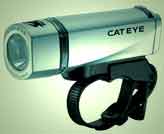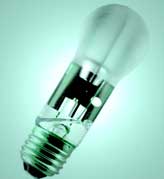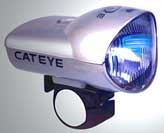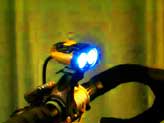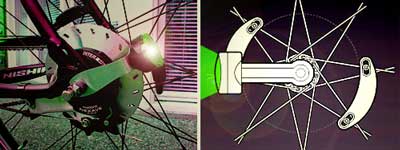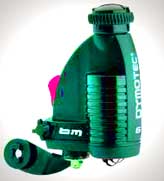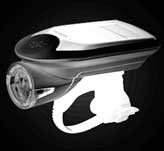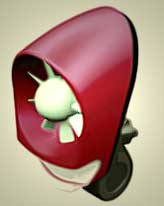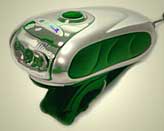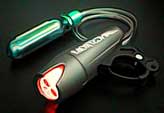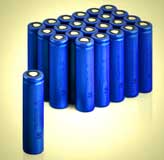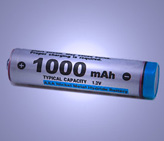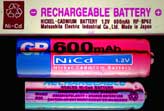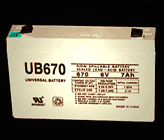Which Bicycle Safety Light … ‘Lamps’ And ‘Power Formats’ Are Best?
Lamp Styles For Your Bicycle Safety Light
When you are buying your bicycle safety lights, you need to look for a lamp with a good quality, efficient bulb.
What defines a good bulb?
Well – a good bulb should convert electricity into light without too many losses, (this usually occurs in the form of heat).
The lamp’s output is measured in –Lumens per Watt. Essentially this is the amount of visible light – per unit of electricity. Therefore the higher the value of Lumens per Watt – the more efficient your light bulb is.
Colour Temperature is another important factor is the light quality. Colour Temperature is measured in Kelvin (K). The higher the number of Kelvin, the closer to pure white light, your bulb is.
In high-power off-road lighting systems, there are presently three primary types of bulbs being used: LEDs (Light Emitting Diodes), Halogen and Metal Halide.
LED – Light Emitting Diode
An LED is not actually a bulb but is, in fact, an incredibly energy efficient – electronic circuit.
The great thing about the LED light is that it is highly efficient, provides a bright white light that has a long run-time.
It also has the added benefit of providing light instantly when switched on – and dimming slowly when running out of power instead of simply cutting out. It is also a flicker-free source of light.
However, the downside of the LED is that – compared to other forms of light bulb – they are generally more expensive and they do have cooling-down issues.
Halogen Lamps
Incandescent halogen lamps have previously dominated the marketplace.
Generally, the halogen lamp is not as efficient and as long-lasting as the LED … nor does it emit a really bright white light – it is more yellow hue.
The halogen requires big, heavy batteries to feed its hunger for power
Halogen lamps are however a cheap and common choice – that are readily available to buy.
HID – High-Intensity Discharge Lamps … aka Metal Halide Lamps
HID lamps have a high colour temperature and consequently produce a bright white light.
They are an efficient light source and have a good run-time, however, the lamp lifespan is decreased by turning the lamp on and off frequently.
The negatives of the HID are that it is expensive, doesn’t illuminate instantly when switched on and when the power is running low the HID will cut out – rather than just dim.
Power Formats For The Bicycle Safety Light
Alternative Energy Sources
If you hate the toxicity and disposal issues surrounding conventional old batteries – then there are a number of terrific green and pretty effective alternative available (or in development).
They Include:
- Dynamo Generators
- Electrodynamic / Magnetic Induction
- Wind-Up
- Wind-Powered
- Hydrogen-Powered
- Hybrid Solar-Powered Batteries
Conventional Batteries
When it comes to regular batteries … there are basically four types of battery formats employed in bicycle lighting systems.
They are:
- Lithium Ion
- NiMH – Nickel Metal Hydride
- Ni-Cad – Nickel-Cadmium
- Lead-Acid
Dynamo Power Generator
Dynamos were designed to use a bicycle’s movement to generate and harness energy.
Dynamos are renowned for being extremely efficient, economical and practical.
Solar Powered & Hybrid Solar Powered / Rechargeable NiMH Battery
Considering the bicycle is such an amazing source of clean energy – it is only fitting that we have solar-powered electrics on our bikes.
With your average solar powered battery lamp, it will take approx two hours of sunlight to charge up the lamp – which in return nets you approx four hours of constant light and approx eight hours in flash mode … give or take depending on your particular lamp.
The hybrid solar powered battery enables you to run your bicycle safety lights using solar power – with the backup of a conventional battery if you need it.
Once the hybrid solar cell has charged up the NiMH battery you should get approx six hours of light. The alkaline back-up battery stores approx an additional thirty hours of light in reserve.
A wind-powered bike light operates by a mini turbine being mounted on the handlebars. It then draws on the bike’s momentum to drive the blades.
The blades then power a 1700 lux LED light. A bicycle travelling at 13 mph or 21 kph will produce continuous power of 3.5 volts at 70mA– with the small generator rotating at approx 850 revs per minute.
The wind-powered bike light also comes equipt with a rechargeable lithium battery for continuous illumination.
Electrodynamic / Magnetic Induction
Harnessing power on your bicycle via – electrodynamic/magnetic induction – involves attaching high-powered, neodymium magnetic arcs to your wheel spokes.
LED lamps are secured to the end of your forks and each time the arcs spin past – light is generated – by electromagnetic induction.
Unlike rim mounted dynamos, there is no friction required.
No batteries are needed for the electrodynamic/magnetic induction lamp – however, the downside is that they do need motion to keep the light source going.
Wind-Up
The wind-up rechargeable bicycle light operates – simply by rotating the handle, to produce a really bright light.
Approx 30 minutes of light will result from cranking the handle for about 60 seconds.
Alternatively, the wind-up light can also be plugged into the electricity mains.
An environmentally friendly option.
Hydrogen-powered
Hydrogen bike lights are fuelled by hydrogen gas which is stored in a 21cc cartridge.
The metal hydride cartridge contains one gram of hydrogen – the energy equivalent to about 10 x AA non-rechargeable alkaline batteries.
The hydrogen-powered lamp provides approx 20 hours of continuous run-time before the storage cartridge needs to be refuelled.
Your hydrogen cartridge can be refilled as often as required, without running the risk of losing your charge capacity- and better still refuelling only takes a matter of minutes to complete.
The true beauty of the hydrogen-powered bike safety light is that its’ only by-product is water vapour!
Lithium Ion Rechargeable Batteries
Lithium Ion Rechargeable Batteries are the latest in battery technology and are used in most expensive modern gadgets.
They are the lightest most efficient and portable of the four battery types – and also the easiest to charge and recharge
However like all good things they do come at a high price and are the most costly of all the batteries.
Unlike the NiMH, they have a limited self-discharge and don’t suffer from the memory effect which plagues the NiCad batteries.
All batteries are environmentally damaging but the Lithium Ion is currently the lesser of four evils.
NiMH – Nickel Metal Hydride Batteries
NiMH Batteries are bigger and heavier than the Lithium Ion batteries (although having a similar capacity)- but still smaller, lighter and slightly less toxic than the NiCad.
The NiMH are pretty robust with constant charging and recharging – however, they are renowned for self-discharging when unused so you will need to recharge them intermittently.
NiCad batteries don’t suffer the memory effect quite so badly as NiCad batteries and therefore won’t gain any noticeable benefit from being fully discharged.
Ni-Cad aka Nickel-Cadmium Batteries
Ni-Cad Batteries are first and foremostly EXTREMELY TOXIC to our environment. They have already been banned in some more progressive countries
In size and weight they are a step up from the old traditional lead-acid battery – and thus comparatively more portable.
To get the best out of the Ni-Cad you need to completely discharge the battery and then recharge it – this avoids the memory effect.
Lead-Acid Batteries
Lead Acid Batteries are old technology.
They are very heavy, and an environmental nightmare to dispose of once finished with.
They may be cheap and commonplace … but they need a super-charger to elicit the best performance from them AND once completely discharged of energy they become damaged and redundant.

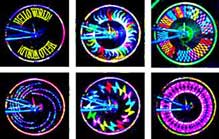 Amp hour
Amp hour